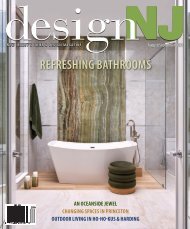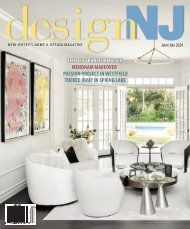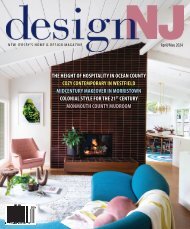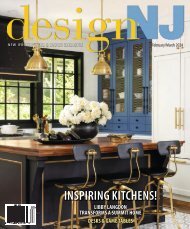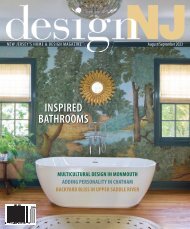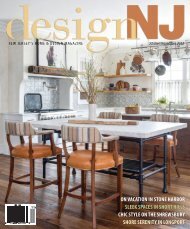DesignNJ-OctNov2023_Digital issue
From a casual coastal home in Sea Girt to a chic Hoboken loft, from a Midcentury-style home to a vineyard-inspired residence that mixes Old World charm and modern design, the October-November issue of Design NJ is filled with inspiration for you to enjoy. The print issue is now arriving in mailboxes.
From a casual coastal home in Sea Girt to a chic Hoboken loft, from a Midcentury-style home to a vineyard-inspired residence that mixes Old World charm and modern design, the October-November issue of Design NJ is filled with inspiration for you to enjoy. The print issue is now arriving in mailboxes.
Create successful ePaper yourself
Turn your PDF publications into a flip-book with our unique Google optimized e-Paper software.
stylenewjersey | ICONIC DESIGN<br />
Modern & Classic<br />
The No. 432 pitcher that Johan Rohde designed for the venerable Georg Jensen,<br />
once labeled too contemporary, becomes an icon of Danish design<br />
BY REN MILLER<br />
Simplicity is the ultimate sophistication. That notable phrase —<br />
sometimes attributed to Leonardo da Vinci but more likely the<br />
paraphrase of a line from “Stuffed Shirts,” a 1931 book by writer,<br />
politician and one-time Union City, New Jersey, resident Clare Boothe<br />
Luce — has been applied in many ways to many people and products.<br />
It seems particularly appropriate for the No. 432 sterling silver water<br />
pitcher designed by Johan Rohde (1856-1935), a Danish painter, product<br />
designer and a somewhat rebel with a cause. After first studying medicine,<br />
Rohde switched direction and entered the Royal Danish Academy of Fine<br />
Arts in 1882 to study painting. He left a year later to protest what he<br />
saw as the school’s refusal to accept modern trends. He enrolled at the<br />
then-new Students’ School of Study in Copenhagen and also became the<br />
principal founder of The Free Exhibition, an association that, to this day,<br />
exhibits works selected by contemporary artists rather than those chosen<br />
by cultural authorities. Along the way he became an important painter<br />
and lithographer as well as a collector of works by other artists.<br />
Rohde also ventured into applied arts with the design of furniture, in<br />
both classical and Japanese styles, and of high-quality silver products for<br />
the home. He commissioned some of the leading Danish workshops to<br />
execute his early designs, including Georg Jensen, the luxury silversmith<br />
based in Copenhagen. Jensen was so impressed that he, in turn,<br />
commissioned Rohde to create some designs for him — mostly cutlery<br />
and hollowware — eventually securing an exclusive lifelong contract with<br />
him. Among the most enduringly popular of Rohde’s designs for Jensen<br />
are the Acorn and Scroll flatware patterns, the Cosmos tea and coffee<br />
service, and the No. 432 water pitcher.<br />
Designed in 1920, the pitcher owes its basic shape to the curves of<br />
Art Nouveau. However, the pitcher has none of Art Nouveau’s typical<br />
flowers and foliage in keeping with Rohde’s modernist leanings. It’s a<br />
study in pure form, flat at the bottom then curving out, back in and out<br />
again slightly as the handle flows into the angled top. The graceful arc<br />
from the base of the handle to the lip of the spout is both simple and<br />
dramatic, classic and modern. The only ornamentation is a row of tiny<br />
silver “pearls” at the base of the handle and, in some variations, a wood<br />
inset in the handle.<br />
The design was considered too aggressively modern in 1920 so Jensen<br />
didn’t put it into production until 1925. That timing seemed to be right;<br />
the pitcher was immediately popular with customers, collectors and<br />
museums, where it is now part of many permanent collections and is<br />
considered an icon of Danish silver design.<br />
The pitcher comes in 11½-inch and 9¼-inch heights in a highpolish<br />
finish that reflects everything around it, almost disappearing<br />
The simplicity of Johan Rohde’s No. 432 water pitcher is at once classic and<br />
modern. This 9¼-inch-tall version of the pitcher was made in 1933. Courtesy<br />
of the Metropolitan Museum of Art; The Cynthia Hazen Polsky Fund, 1989.<br />
on a tabletop if not for the gracious silhouette. The pitcher remains<br />
available by commission from Georg Jensen. Or check with antiques<br />
dealers or websites such as 1stDibs.com and Etsy.com, where prices vary<br />
substantially based on size and condition, reaching around $6,000 for the<br />
9¼-inch size to more than $12,000 for the 11½-inch size.<br />
Interestingly, in 1934, one year before his death, Rohde received the<br />
Thorvaldsen Medal, the highest visual arts honor given by the Royal<br />
Danish Academy of Fine Arts, the very institution he had Spurned a half<br />
century earlier, indicating all was forgiven on both sides. DNJ<br />
For contact information, page 64<br />
22 October/November 2023



